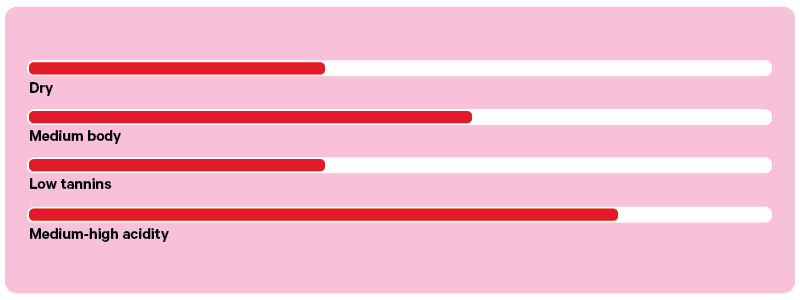Guide to Pinot Noir
In New Zealand, we’re lucky to have delicious Pinot Noir on our doorstep. Here’s how to shop for your next bottle.

What type of wine is Pinot Noir?
Pinot Noir is a red wine with medium body, softer tannins and a lovely ‘morish’ quality that will leave you wanting another glass before you’ve even finished the one you’re drinking.
It's the second most planted grape variety in New Zealand behind Sauvignon Blanc - for a good reason. Although Pinot grapes are difficult to grow, our local wineries manage to wow the world each year.
This guide helps everyday Kiwi shoppers understand Pinot Noir, and what to look for in a bottle.
Pinot Noir flavours, taste and tips
Strawberry | Cherry | Plum | Mushroom |

Storing and serving
|
|
|
Before serving: | Once opened: | Serving: |
| Store in a cool, dark place at 7-13°c. Enjoy within 5-8 years (more quality wines will last longer and improve over time). | Store in the fridge and drink within 3-5 days. Or 2 weeks if used for cooking. | Tad cooler than room temp, around 15°c |
Pinot Noir average nutrition in 150ml glass (1 serving)
Alcohol 13% | Calories 120 Calories | Sugar 0.5 grams | Carbohydrates 3.4 grams |
How much do I spend?
Fortunately for us in New Zealand, Pinot Noir is now becoming more affordable. Well-made, quality Pinot Noir can be less than $25 a bottle. There are incredible high-end examples for under $100, and some of the top Burgundy can cost well into four figures! Read our wine pricing guide for more.
What's a good Pinot Noir to buy?
1 / 0
Pinot Noir compared to other wines
Pinot Noir is a red wine, closely related genetically to the white varietals Pinot Blanc and Pinot Gris. But although they’re similar grapes, the flavours (and of course colours) are a different story.
Body:
Pinot Noir is light to medium-bodied, with a soft, delicate feel in your mouth. Pinot Gris is also medium-bodied but offers a richer experience according to the experts.
Acidity:
Both wines have moderate to high acidity.
Dryness/sweetness and taste:
Pinot Noir is dry, with flavours of red fruits like cherry and raspberry, often accompanied by earthy or floral tastes. Pinot Gris can range from dry to off-dry, with pear, apple, and stone fruit flavours, sometimes with a touch of spice. Pinot Noir tends to have more complex flavours, while Pinot Gris is fruitier.
Learn about Pinot Gris
Body:
Pinot Noir is light to medium-bodied, and experts describe a soft, silky texture. Malbec in contrast is full-bodied, and is richer and dense.
Acidity:
Pinot Noir has moderate to high acidity—a more fresh, vibrant drop. Malbec has lower acidity, contributing to a smoother taste.
Dryness/sweetness and taste:
Pinot Noir is dry, with flavours of red fruits like cherry and raspberry, often paired with earthy or floral tastes. Malbec is also dry but features bolder, darker fruit flavours like blackberry and plum, along with hints of chocolate and leather.
Body:
Pinot Noir is light to medium-bodied and experts would say, a smoother, more delicate wine. Cabernet Sauvignon is full-bodied, so it’s much richer and a deeper, darker red.
Acidity:
Pinot Noir has moderate to high acidity, that’s fresh and vibrant. Cabernet Sauvignon has moderate acidity that balances the big, bold experience.
Dryness/sweetness and taste:
Pinot Noir is dry, with flavours of red fruits like cherry and raspberry, along with earthy, floral notes. Cabernet Sauvignon is also dry but has darker fruit flavours like blackcurrant and plum, often with notes of tobacco, oak, and spice.
Learn about Cabernet Sauvignon
Body:
Pinot Noir is light to medium-bodied. Shiraz/Syrah is medium to full-bodied, providing a bolder feel in the mouth.
Acidity:
Pinot Noir has moderate to high acidity, giving it a fresh and lively finish. Shiraz/Syrah has moderate acidity, which balances its richness and intensity.
Dryness/sweetness and taste:
Pinot Noir is dry, with flavours of red fruits like cherry and raspberry, often complemented by earthy and floral tastes. Shiraz/Syrah is also dry, but tends to have darker fruit flavours like blackberry and plum, along with peppery, spicy, and sometimes smoky undertones.
Experts describe Pinot Noir as more delicate, while Shiraz/Syrah is bolder and more intense.
Learn about Shiraz/Syrah
Body:
Pinot Noir is light to medium-bodied, smooth and silky. Chardonnay ranges from medium to full-bodied, offering a richer, creamier feel in the mouth, especially when oak-aged.
Acidity:
Both wines have moderate to high acidity, providing a fresh, vibrant finish. Remember Chardonnay can range from crisp and zesty to creamy, depending on the style and where it’s grown.
Dryness/sweetness and taste:
Pinot Noir is dry, with flavours of red fruits like cherry and raspberry, alongside earthy or floral notes. Chardonnay is usually dry, with flavours of citrus, green apple, and tropical fruits, or with big, buttery or oaky notes if aged in barrels.
Learn about Chardonnay
Which food does Pinot Noir pair well with?
Pinot Noir pairs extremely well with chicken and lamb as well as pasta and Italian dishes. One of the most food-friendly wine varietals, Pinot enhances the totality of the flavours and enjoyment of the food. Read our food pairing guides for more.
Pinot Noir FAQs
Pinot Noir goes well with a variety of dishes and flavours. Here are some options:
- Roast chicken or turkey
- Grilled salmon or tuna
- Mushroom dishes like risotto or pasta
- Pork (roast or tenderloin)
- Lamb (especially with herbs like rosemary)
- Cheeses like Brie or Gruyère
- Dark chocolate
Its light tannins and fruity flavours complement earthy, savoury dishes without overpowering them.
Read our food pairing guides for more
You can tell if your Pinot Noir is off by checking for signs like a brownish colour, a sour or vinegar-like smell, or a flat, unpleasant taste.
When the wine has lost its fresh fruitiness, sadly, it’s time to throw down the drain
Each region’s climate and soil bring unique characteristics to the wine.
- Central Otago: Known for bold, fruit-driven Pinot Noirs with vibrant cherry and plum flavours.
- Marlborough: Produces lighter, more elegant Pinot Noir with red fruit and herbal flavours.
- Martinborough: Offers earthiness, with silky tannins and flavours of dark fruit and spice.
- Canterbury/Waipara: Known for a mix of fruitiness and earthy characteristics with great balance.
- Nelson: Produces bright, aromatic Pinot Noir with red fruit and floral notes.
Pinot Noir is best served in a large, wide-bowled glass with a slightly narrower opening than the bowl. A Burgundy glass is ideal and classy at that. This shape allows the wine to breathe and helps concentrate the smells and flavours. Only fill halfway and give it a gentle swirl. Take a quick sniff before you taste it - and see if you can identify the aromas. Enjoy!
Yes, it’s a delicious addition to recipes! Its light body and fruity flavours make it great for adding to stews, lamb, or mushroom-based dishes.
Pinot Noir adds depth and richness to sauces, marinades, and reductions, especially in slow-cooked meals or when paired with meats and earthy veges.
Just make sure to use a wine you’d also enjoy drinking.
Yes, it's true! Pinot Noir is one of the main grapes used in Champagne, along with Chardonnay and Pinot Meunier.
Even though Champagne is a white or rosé wine, adding Pinot Noir helps create complexity, fruit flavours and depth, according to the experts.
- Burgundy, France - The birthplace of Pinot Noir
- Willamette Valley, Oregon, USA
- Sonoma Coast, California, USA
- Mornington Peninsula, Australia
- Alsace, France
History of Pinot Noir
Pinot Noir was first planted in New Zealand in the 19th century, but it wasn’t until the 1970s and 80s that it took off.
Central Otago, Marlborough, and Martinborough became key growing regions. Our cool climate and soils have helped elevate it to international recognition.
Today, New Zealand Pinot is celebrated globally for its vibrant fruit flavours and unique regional styles.
Pinot Noir is a very old grape, grown and enjoyed by the Gauls in 500 BC.
The home of Pinot Noir is still the Burgundy region of France, particularly the Cote-d’Or.


































